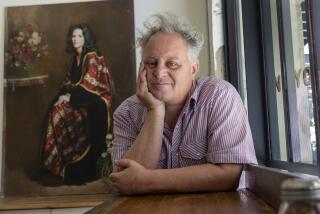Art Fraud Suspect’s Bail Cut : Meanwhile, Buyers Worry They May Hold Fakes
Despite a prosecutor’s fear that the suspect might flee the country, a Municipal Court judge Friday reduced the bail of a French national who was arrested for allegedly trying to peddle a phony Renoir masterpiece to an undercover police officer.
Deputy Dist. Atty. Reva Goetz had asked Los Angeles Municipal Judge David S. Milton to raise the bail of art dealer Frank De Marigny to $5 million, up from the original $1 million. De Marigny is the only person arrested so far in a major police investigation into alleged art fraud.
After De Marigny’s attorney pointed out that the attempted grand theft charge filed against his client carries only a three-year maximum sentence, the judge reduced the bail to $250,000.
Meanwhile, police said Friday that they have been deluged with calls from people asking whether their artworks may be phonies.
Galleries, Homes Raided
Police late Wednesday and early Thursday seized 1,687 allegedly phony lithographs and other artworks from eight outlets of The Upstairs Gallery, including the firm’s Huntington Beach warehouse, and two homes, including De Marigny’s Manhattan Beach home and a home in Marina del Rey.
Detective Bill Martin, the police department’s expert on art fraud, said officers were telling worried collectors to take the artworks to reputable dealers for appraisal. He advised anyone who is holding a fraud to notify police.
“Until they get it authenticated, there’s no crime,” said Martin.
He said that as far as he knows, all of the art believed to be fraudulent has been removed from The Upstairs Gallery stores.
The store on Rodeo Drive in Beverly Hills was open Friday with a full stock. A clerk pointed to an empty space on the wall where she said a painting had just been sold.
Company officials, who said Thursday they believe that they might have been duped by unscrupulous art wholesalers, could not be reached for additional comment.
At De Marigny’s bail hearing, Goetz revealed that a Japanese art investor was bilked out of $3 million when he bought several allegedly fraudulent works. Goetz would not elaborate on exactly where the art was purchased, or on other details in the case.
Goetz said that investigators are checking to see whether De Marigny has a criminal record in Europe. She said the man, who drives a Rolls-Royce and lives in a rented beachfront house in Manhattan Beach, may have been planning to move to Switzerland. She said the man’s landlord had called police and told them of De Marigny’s purported plans.
De Marigny’s attorney, Alvin S. Michaelson, said his client was only planning to go on vacation. He said the French national has lived for seven years in the United States and would not skip bail over an offense that carries only a three-year maximum prison term, of which only usually half is normally served.
“He is well known throughout the city as an art dealer,” Michaelson said, but he added that with the publicity about his arrest, potential buyers will steer clear of De Marigny.
A prominent Beverly Hills art dealer, who asked that his name not be used, said in an interview Friday that a year ago, De Marigny “came to me a couple of times offering some Renoirs,” which the dealer described as “less than creme de la creme.”
The discussion about the works did not get far enough for the dealer to know whether they were originals or fakes.
“I didn’t know him. I’ve never done business with someone I don’t know. I wasn’t interested.”
Detective Martin said the problem of fraudulent art is enormous--and growing. “‘You’re talking about maybe $100 million worth of (fraudulent) graphics that could have been sold throughout the United States,” he said.
Charlotte Sherman, an appraiser for the Art Dealers Assn. of Southern California, said her group has noticed more fakes than ever in the Los Angeles area, some of them apparently produced with sophisticated and costly laser scanning equipment that can “duplicate prints with a margin of error that is very slim.”
“We can frequently spot them, but it often takes an expert who’s been around for 30 years to determine, for example, whether a color sequence is wrong,” Sherman said.
Typically, forgers photograph an artwork, then transfer the image to a lithograph plate or silk-screen process, said Bruce Davis, curator of prints and drawings at the Los Angeles County Museum of Art.
Producing phony art is an expensive process, Sherman said.
“You almost always have to have an expensive print shop, reams and reams of paper, colors and inks,” Sherman said. “These days, the last thing an appraiser looks at is the signature because they (lithographs) are so easy to reproduce.”
But selling fake artworks is not always illegal. A Carlsbad firm is advertising its collection of fake art in the October issue of Architectural Digest, including a picture of the same Renoir painting that De Marigny allegedly tried to peddle to the undercover officer.
Martin said he may check to see whether De Marigny may have obtained the fake “Young Girl With Daisies” from the firm that placed the ad, the Bianco Collection. Telephone operators at the company would not allow a reporter to speak with the manager. Martin said the firm’s operations are legal because they are selling their works clearly labeled as fakes.
The real copy of the painting hangs in the Metropolitan Museum of Art in New York.
More to Read
The biggest entertainment stories
Get our big stories about Hollywood, film, television, music, arts, culture and more right in your inbox as soon as they publish.
You may occasionally receive promotional content from the Los Angeles Times.











